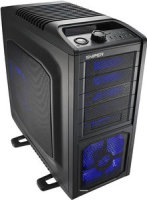Friday, February 27. 2009
‘davinci’ up and running (like hell)

Two days ago I finished assembling my new workstation and set up a 64-bit Debian ‘lenny’ on it. When I decided to go for Intel Core i7 I wasn’t aware that due to Intel’s Hyperthreading technology each of the four cores is able to handle two threads at once, making it effectively an eight(!)-core system to the OS! Dig this:
I thought that the onboard Intel SATA-RAID controller provided a hardware RAID, but it’s just a software RAID in disguise, so I can well let Linux do the job. Then I had problems setting up WLAN with the Atheros card I built in, but thanks to the MadWifi project I got it running. What else? Yes, Memtest86 v3.5 didn’t boot on Core i7 and/or 6 GB RAM, but Memtest86+ v2.11 did.
I named the new system ‘davinci’, honoring the technological genius Leonardo da Vinci, what is consistent with the weapon-like appearance of the Cooler Master Storm Sniper case. ![]()

I proudly list the installed components here:
- CPU: Intel Core i7-920 4×2.67GHz
- RAM: OCZ Platinum 3×2GB DDR3-1600 SDRAM, CL7-7-7-24
- Mainboard: Asus P6T Deluxe, 6×DDR3-1333 slots
- GPU: Zotac GeForce GTX 260 AMP²! Edition, 896MB GDDR3, PCIe 2.0 ×16, 2×DVI
- Harddisks: 2× Western Digital RE3 1TB SATA II, RAID-1
- Optical drive: LG Electronics GH22LS30 SATA, 22×/8×/12× DVD±R/+RW/-RAM
- WLAN: D-Link AirPlusXtremeG DWL-G520, 108Mbit, PCI
- Case: Cooler Master CM Storm Sniper
- Power supply: Cooler Master Silent Pro 700W
- Monitor: Samsung SyncMaster 2693HM 26″ TFT-LCD, 1920×1200, DVI, HDMI, speakers, USB
- Input devices: Logitech Cordless Desktop Wave
Currently I just use Intel’s boxed CPU cooler, so I haven’t done any overclocking yet. I’m having an eye on the Cooler Master V10 that’ll be available by April. With this I aim to overclock the cores to 3.2 GHz for the first time, what I might increase to a maximum of 3.8 GHz one day.
Sunday, February 8. 2009
ORF.at: Wie Computer sehen lernen

Der ORF hat einen Artikel zur von mir vorgestern erwähnten Ö1-Sendung nachgeworfen, offenbar als Vorschau auf die heutige Sendung „Matrix“ um 22.30h, in der es ebenfalls um Computer Vision bzw. maschinelles Sehen geht. Die Autoren erwähnen dabei auch die Möglichkeit, dass die Community für korrekt annotierte Trainingsdaten sorgt, die dann den Machine Learning-Algorithmen zur Verfügung stehen – eine Sache, die mich auch beruflich beschäftigt. Bin gespannt, wie sich das alles weiterentwickelt.
Friday, February 6. 2009
Ö1 Digital.Leben: Wie Digicams Gesichter erkennen

Es ist immer spannend, wenn das, womit man sich (z.B. beruflich) einhergehend beschäftigt, beginnt, sich allmählich in der Gesellschaft niederzuschlagen, vor allem wenn die Entwicklung zuvor von der Öffentlichkeit unbeobachtet in „Elfenbeintürmen“ (Labors, Forschungs- & Entwicklungsabteilungen, Uni-Instituten udgl.) stattgefunden hat. Es ist nämlich damit zu rechnen, dass Anwendersoftware bald in der Lage ist, Bild- und Videoinhalte tatsächlich auch zu sehen. So wäre etwa zu erwarten, dass in jüngerer Zukunft nach dem Hochladen eines Bildes in einem einschlägigen Webportal vorgeschlagen wird, das Bild z.B. mit den Schlagworten „Auto“, „rot“, „Straße“ oder „Strand“, „Meer“, „Küste“ zu versehen, sofern eine einschlägige Szene abgebildet ist.
Was bereits Realität ist, sind lernfähige Gesichtserkennungsfunktionen in aktuellen Digitalkameras und Bildverwaltungsanwendungen. Mit den technischen Hintergründen dieser nun Alltag gewordenen Funktion beschäftigte sich die gestrige Ö1-Sendung „Digital.Leben“.
Maschinelles Sehen
[...] Wir Menschen können Gesichter ganz gut anhand von winzigen Details unterscheiden, wie aber macht das ein Computer? Die Antwort weiß Horst Bischof, Professor für maschinelles Sehen an der Technischen Universität Graz.
Ich erlaube mir, hier eine Kopie des Podcasts zur Verfügung zu stellen:
Mehr zum Thema wird für die Ö1-Sendung „Matrix“ am Sonntag, 8. Februar, 22:30h angekündigt.
Sunday, February 1. 2009
Workstation #4 coming soon

Processing images with my current notebook (1.6 GHz CPU, 1 GB RAM) finally is a real pain in the ass. Having the RAW converter render some JPEGs while the HDR software performs tonemapping, it becomes impossible to do image editing or even browse the web at the same time, as the mouse pointer only moves stutteringly like in those “good old days”. In addition, my 160 GB disk is almost full. My computer usage history documents the years where I got a PC (for the use as a workstation, not counting those few boxes for my server and firewalling experiments): 1995, 1998 and 2001; the notebook’s from 2004. So, it’s about time for an upgrade.
When I first thought about whether it should be a notebook again, I noticed that I don’t use my current notebook “on the road” anyway. And notebooks don’t have the computing power of dedicated desktop machines.
Nerds who buy a new PC every year are probably surprised that a Linux geek like me gets along with that few hardware upgrades. Well, my strategy is more like: Buy rarely, but wisely. I don’t feel well when messing around on a productive machine that is supposed to work; just a matter of experience. Thus, I select the components for my new PC carefully and according to my demands: Fast, multi-core, RAM expandable, good disk size, RAID-1, average good GPU, and—very important—silent operation. The price for the box should traditionally be around EUR 1,500 (formerly ATS 20,000). These are now my considerations:
Continue reading "Workstation #4 coming soon"